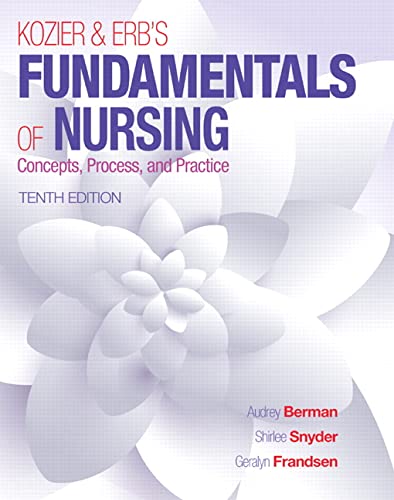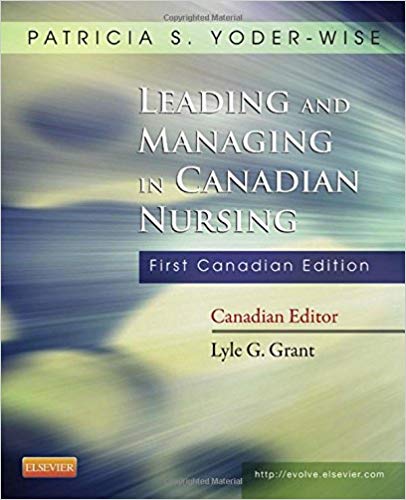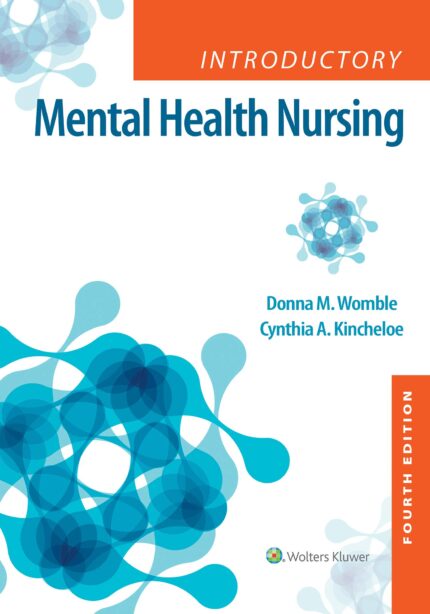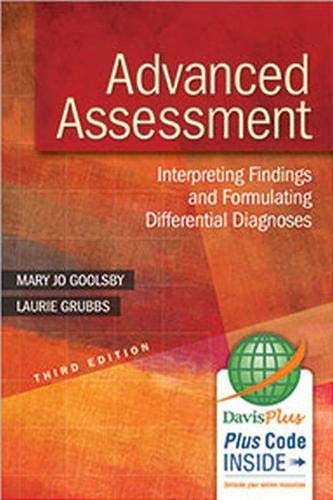Test Bank For Kozier And Erbs Fundamentals Of Nursing 10th Edition by Berman
Test Bank For Kozier And Erbs Fundamentals Of Nursing 10th Edition by Berman
Kozier And Erbs Fundamentals Of Nursing 10th Edition by Berman – Test Bank
Kozier And Erbs Fundamentals Of Nursing 10th Edition
Kozier And Erbs Fundamentals Of Nursing
Chapter 1 Historical and Contemporary Nursing Practice
1) The nurse is reviewing historic events in nursing for a presentation to be provided to new
nursing students. In which chronological order should the nurse present these events? Begin with
the earliest (1) and end with the most recent (5).
1. The Order of Deaconesses opens a small hospital in Kaiserswerth, Germany
2. The Knights of St. Lazarus dedicate themselves to the care of people with leprosy, syphilis,
and chronic skin conditions.
3. During the American Civil War (1861-1865), Harriet Tubman (among other nurses)
administered to the care of slaves and injured soldiers.
4. World War II casualties created an acute shortage of care, and the Cadet Nurse Corps was
established in response to the shortage of nurses.
5. During the Crimean War (1854-1856), Ms. Nightingale administered to the solders following
a request by Sir Sidney Herbert of the British War Department.
Answer: 2, 1, 5, 3, 4
Explanation: 1. In 1836, Theodore Fliedner reinstituted the Order of Deaconesses and opened a
small hospital and training school in Kaiserswerth, Germany, where Florence Nightingale
received her training.
2. Religion played a significant role in the development of nursing. The crusades saw the
formation of several orders of knights who provided care to the sick and injured, including the
Knights of St. Lazarus.
3. During the American Civil War (1861-1865), Harriet tubman (among other nurses)
administered to the care of slaves and injured soldiers.
4. World War II casualties created an acute shortage of care, and the Cadet Nurse Corps was
established in response to the shortage of nurses.
5. During the Crimean War (1854-1856), Ms. Nightingale administered to the solders following
a request by Sir Sidney Herbert of the British War Department.
Page Ref: 3
Cognitive Level: Applying
Client Need/Sub: Safe and Effective Care Environment: Management of Care
Standards: QSEN Competencies: II.C. 3. Value the perspectives and expertise of all health team
members | AACN Essentials Competencies: I. 9. Value the ideal of lifelong learning to support
excellence in nursing practice | NLN Competencies: Knowledge and Science; Knowledge; The
state of science in nursing | Nursing/Integrated Concepts: Nursing Process: Planning
Learning Outcome: 1. Discuss historical factors and nursing leaders, female and male,
influencing the development of nursing.
MNL LO: 1.2.1. Explore the various roles in nursing practice.
2) The nurse is caring for a nurse who provided care to soldiers during the Vietnam War. What
information in this patient’s history should the nurse use to understand the patient’s nursing
career?
1. The patient was still a student when serving in the war.
2. The patient’s first patient care experiences were during a time of war.
3. The patient decided to leave the profession after serving in the war.
4. The patient contracted long-term illnesses from being overseas in a war.
Answer: 2
Explanation: 2. During the Vietnam War, approximately 11,000 American military women
stationed in Vietnam were nurses. Most of them volunteered to go to Vietnam right after they
graduated from nursing school, making them the youngest group of medical personnel ever to
serve in wartime.
Page Ref: 4
Cognitive Level: Applying
Client Need/Sub: Safe and Effective Care Environment: Management of Care
Standards: QSEN Competencies: II.C. 3. Value the perspectives and expertise of all health team
members | AACN Essentials Competencies: I. 9. Value the ideal of lifelong learning to support
excellence in nursing practice | NLN Competencies: Knowledge and Science; Knowledge; The
state of science in nursing | Nursing/Integrated Concepts: Nursing Process: Assessment
Learning Outcome: 1. Discuss historical factors and nursing leaders, female and male,
influencing the development of nursing.
MNL LO: 1.2.1. Explore the various roles in nursing practice.
3) The nurse is reviewing public health and health promotion roles for available for nurses. To
which leader should the nurse attribute the development of these roles?
1. Clara Barton
2. Lillian Wald
3. Mary Brewster
4. Florence Nightingale
Answer: 4
Explanation: 4. Florence Nightingale’s vision of nursing included public health and health
promotion roles for nurses, but it was only partly addressed in the early days of nursing. Her
focus tended to be on developing the profession within the hospitals. Clara Barton is noted for
establishing the American Red Cross. She persuaded Congress to ratify the Treaty of Geneva in
1882 so that the Red Cross could perform humanitarian efforts in times of peace. Lillian Wald is
considered the founder of public health nursing. She and Mary Brewster were the first to offer
trained nursing services to the poor in the New York slums and developed the Visiting Nurse
Service, along with the Henry Street Settlement.
Page Ref: 6
Cognitive Level: Analyzing
Client Need/Sub: Safe and Effective Care Environment: Management of Care
Standards: QSEN Competencies: II.C. 3. Value the perspectives and expertise of all health team
members | AACN Essentials Competencies: I. 9. Value the ideal of lifelong learning to support
excellence in nursing practice | NLN Competencies: Knowledge and Science; Knowledge; The
state of science in nursing | Nursing/Integrated Concepts: Nursing Process: Implementation
Learning Outcome: 1. Discuss historical factors and nursing leaders, female and male,
influencing the development of nursing.NURSINGTB.COM
MNL LO: 1.2.1. Explore the various roles in nursing practice.
4) The nurse has been asked to participate on the hospital’s Shared Governance Committee. To
which nurse leader should the nurse attribute the ability for nurses to control the profession?
1. Mary Breckinridge
2. Lavinia Dock
3. Margaret Higgins Sanger
4. Virginia Henderson
Answer: 2
Explanation: 2. Lavinia Dock was a feminist, writer, and activist. She participated in protest
movements for women’s rights that resulted in passage of the 19th Amendment, which allowed
women the right to vote. In addition, Dock campaigned for legislation to allow nurses, rather
than physicians, to control their profession.
Page Ref: 7
Cognitive Level: Applying
Client Need/Sub: Safe and Effective Care Environment: Management of Care
Standards: QSEN Competencies: II.C. 3. Value the perspectives and expertise of all health team
members | AACN Essentials Competencies: I. 9. Value the ideal of lifelong learning to support
excellence in nursing practice | NLN Competencies: Knowledge and Science; Knowledge; The
state of science in nursing | Nursing/Integrated Concepts: Nursing Process: Diagnosis
Learning Outcome: 1. Discuss historical factors and nursing leaders, female and male,
influencing the development of nursing.
MNL LO: 1.2.1. Explore the various roles in nursing practice.
5) While a nurse is conducting a health assessment, the individual asks why the term “patient” is
being used. What should the nurse explain about the implication of the term “patient”?
1. The person is seeking assistance because of illness.
2. The individual is proactive in his or her health care needs.
3. The person is a collaborator in his or her care.
4. The individual is using a service or commodity.
Answer: 1
Explanation: 1. The word patient comes from a Latin word meaning “to suffer” or “to bear.”
Usually, people become patients when they seek assistance because of illness or for surgery.
Some nurses believe that the word patient implies passive acceptance of the decisions and care
of health professionals, which would be opposite of being proactive in one’s health care needs.
The term client presents the recipient of health care as a collaborator in that care, along with the
people who are providing service. A consumer is an individual, a group of people, or a
community that uses a service or commodity.
Page Ref: 13
Cognitive Level: Applying
Client Need/Sub: Safe and Effective Care Environment: Management of Care
Standards: QSEN Competencies: II.C. 3. Value the perspectives and expertise of all health team
members | AACN Essentials Competencies: I. 9. Value the ideal of lifelong learning to support
excellence in nursing practice | NLN Competencies: Knowledge and Science; Knowledge; The
state of science in nursing | Nursing/Integrated Concepts: Nursing Process: Implementation
Learning Outcome: 5. Describe how the definition of nursing has evolved since Florence
Nightingale.
MNL LO: 1.2.1. Explore the various roles in nursing practice













